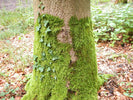
Effective tips for lichen removal: Natural and chemical solutions
, 5 min reading time

, 5 min reading time
#VALUE!

Lichens can be an eyesore for anyone who wants to maintain a tidy garden or facade. They are persistent and sometimes seem impossible to remove, but with the right approach you can combat them effectively. I have tried different methods myself and would like to share my experiences and tips.
In this article you will discover the most effective ways to remove lichens. Whether it concerns natural solutions or chemical remedies, I discuss the pros and cons of each method. This way you can make a well-considered choice and let your environment shine again.
Lichens can cause both aesthetic and functional problems. Understanding what lichens are and why it is important to remove them is crucial.
Lichens are symbiotic organisms, formed by a collaboration between fungi and algae or cyanobacteria. They grow slowly and can adapt to extreme conditions. With their different shapes and colors, lichens can grow on stones, trees, and walls.
Lichens affect aesthetics by causing unwanted stains on surfaces. In addition, they can damage materials by retaining moisture, leading to accelerated wear of bricks and concrete. They can also hinder the growth of other plant organisms by extracting nutrients from the surfaces.
Removing lichens makes surfaces look cleaner and better maintained. This means that materials last longer and the environment retains its aesthetic value.
There are several effective methods available for removing lichens. I will discuss the three major categories: chemical, mechanical and natural solutions.
Chemical methods provide a fast and powerful way to remove lichens. I often use algae and moss killers that have been specifically developed for this purpose. These products usually contain active ingredients such as benzoic acid, sodium hypochlorite or potassium salts. It is important to follow the instructions carefully to avoid damage to plants and surfaces. After application, lichens usually turn black within a few days to weeks and fall off the treated surface.
Mechanical methods are manual and require more physical effort, but are more environmentally friendly. I often recommend using a stiff brush or a pressure washer depending on the surface. Caution is advised on vulnerable surfaces, such as old facades. By wetting the surface and then brushing it vigorously, I can effectively remove lichens. I can spray away stubborn lichens with a high-pressure cleaner, but I make sure that the pressure is not too high to avoid damage.
For an environmentally friendly approach, I often choose natural remedies. Vinegar and lemon juice are good examples of natural acids that can be effective against lichens. I mix white vinegar with water in a 1:1 ratio and apply it to the lichens with a spray bottle. After soaking for several hours, I clean the surface with a brush. Sprinkling salt on the lichens and letting it sit for a few days also often helps.
By combining or alternating these methods, I can effectively remove lichens and preserve the aesthetic value of surfaces.
Preventing lichens is more effective and less labor intensive than removing them. Below I discuss my methods for preventive treatments and regular maintenance and cleaning.
Preventive treatments reduce the risk of lichens. I use hydrophobic coatings to make surfaces water-repellent. These coatings prevent moss and algae from settling. Another effective method is applying copper strips to roofs and walls. When rainwater flows over these strips, a small amount of copper ions are released, which inhibit the growth of lichens. Finally, I choose environmentally and climate-friendly paints with built-in algae and anti-fungal properties.
Regular maintenance prevents lichen build-up. I clean surfaces at least twice a year with a pressure washer. For sensitive surfaces I use a soft brush and a mild detergent. I regularly check surfaces for early signs of lichen growth and remove them immediately with a stiff brush. Pruning trees and shrubs around buildings and paths promotes air circulation and reduces moisture levels that promote lichens.
When removing lichens, it is important to consider environmentally friendly methods to minimize damage to the ecosystem. The impact of chemical products and sustainable alternatives are discussed below.
Chemicals can be effective at removing lichens, but they also pose significant environmental risks. Chemicals such as bleach and ammonia can be harmful to plants, animals and water sources in the area. Studies have shown that these substances can reduce soil quality and negatively impact biodiversity. That is why I limit the use of these products to a minimum.
Sustainable methods can effectively control lichens without negative environmental impacts. Natural cleaning products such as vinegar and lemon juice offer a safe option. Brush off lichens with a mixture of water and natural cleaning agents for optimal results. Mechanical methods such as using a pressure washer or a stiff brush are also environmentally friendly. Through regular maintenance I ensure that lichens do not have a chance to become established.
Removing lichens requires a thoughtful approach. By applying a combination of preventative measures and regular maintenance routines, we can effectively limit lichen growth. The use of environmentally friendly methods not only contributes to a cleaner environment but also ensures a sustainable solution. By consciously choosing natural cleaning products and mechanical cleaning, we can maintain the aesthetic value of our gardens and facades without harming the ecosystem.


